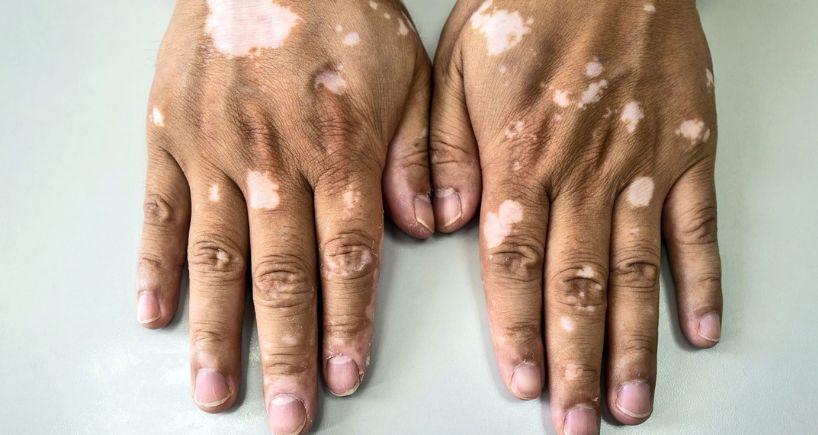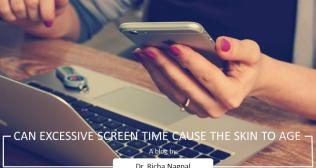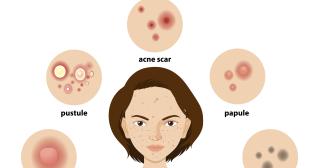
Vitiligo Overview: Symptoms, Causes, Types, and Risks
Vitiligo is a chronic skin defect characterized by the loss of skin pigmentation, resulting in the formation of white patches on different regions of the body. This condition affects people of all skin types and can have a marked effect on one’s physical appearance and mental well-being. The areas of skin that lose their pigment are called macules. If vitiligo hits any body part with hair, the hair may turn white or silver. There is no known cause of vitiligo. It is hypothesized to be a consequence of the combination of genetic, autoimmune, and environmental factors. These factors destroy melanocytes, which are skin cells that produce melanin, a biological pigment (biochrome) that gives the skin its color or pigmentation.
Symptoms of Vitiligo
The most common symptom of vitiligo is the loss of natural color or pigment. Symptoms, in general, include:
- Loss of color in hair
- Loss of color in the mucous membrane
- Changes in eye color (retina or inner layer of eyeball)
The depigmented regions include:
- Mouth and eyes
- Palms (wrist and fingers)
- Groin regions
- Genital areas
- Inner mouth and nose – mucous membranes
- Hairs – scalp, eyebrow, eyelash, beard, and body hair
In addition to the above symptoms, people might also experience:
- Poor quality of life due to lack of self-confidence
- Uveitis – a condition that causes inflammation inside the eyes
- Inflammation in the ear
Causes of Vitiligo
While the exact cause of vitiligo is a mystery, researchers believe that vitiligo occurs when the body’s immune system attacks and destroys melanocytes. In addition, sunburn, emotional distress, or chemical exposures can trigger the condition to make it worse.
- Autoimmunity: Autoimmunity is believed to be the leading and most commonly accepted cause of vitiligo. It occurs when the body’s immune system mistakenly targets and destroys its own melanocytes responsible for producing melanin.
- Genetic: Genetic factors are believed to account for about 30% of vitiligo cases. Variations in the activities of these genes make it more difficult to control inflammation and prevent one’s immune system from attacking one’s own tissues.
- Heredity: Hereditary cause of vitiligo is more likely to occur in people with a family history of this condition. However, studies have shown that hereditary cannot guarantee one to develop vitiligo.
- Environmental Factors: Environmental factors, such as exposure to ultraviolet radiation, contact with certain chemicals or certain skin-whitening products, might precipitate vitiligo in vulnerable individuals.
- Neurogenic Factors: Larner, in 1959, first postulated the neuronal theory for vitiligo. According to this theory, the nerve endings in the skin release cytotoxic substances, leading to the destruction of melanocytes.
Types of Vitiligo
Based on the number and location of patches, dermatologists have classified vitiligo as follows:
- Focal Vitiligo: It is a rare form of vitiligo characterized by a few small spots of white patches in a localized region of the body. The patches are small, hypopigmented, and secluded. They do not spread to other regions for one or two years.
- Generalized Vitiligo: This is the most common type of vitiligo. It presents symmetrically and often starts on the hands, feet, or around the eyes and progresses throughout one’s life. This type of vitiligo is responsive to medical therapies if detected early.
- Segmental Vitiligo: It is an early-onset vitiligo, appearing on one side of the body without crossing the midline. It presents as an isolated segment, rapidly progresses for 6–24 months, and then halts.
- Trichrome Vitiligo: This is a clinical variant of vitiligo with characteristic three different sections in appearance. It contains three zones: Unaffected region, intermediate region of hypopigmentation, and depigmented region.
- Confetti: This type of vitiligo presents as very small spots of depigmentation of about 1–3 mm in size, often clustering into larger spots.
Risks and Complications
Though vitiligo does not cause physical pain and discomfort, it can prompt several risks affecting both physical and mental well-being.
- Psychosocial Effect: Vitiligo can cause a significant burden on one’s psychosocial well-being. It is often driven by the need to conceal lesions and communal beauty ideals, leading to stress, depression, and lack of self-esteem. The visible nature of this condition can lead one to face social stigma, discrimination, bullying, and increased attention-seeking. All these can often present as lack of self-confidence and social withdrawal.
- Sun-Sensitivity: Vitiligo patients are more sensitive to sunlight. Patients affected with vitiligo do not have enough melanin in their skin. This pigment protects the skin from harmful ultraviolet (UV) rays. It can result in easy sunburns and trigger the condition to spread.
- Autoimmune Conditions: Since vitiligo can significantly impact one’s immunity, it can pose a significant risk of other autoimmune disorders due to atypical immune system activation. People with vitiligo are at a higher risk of type 1 diabetes, thyroid diseases, alopecia areata (an autoimmune hair loss condition), and pernicious anemia.
- Ear and Eye Issues: Although less common, vitiligo can affect the eyes and ears. Depigmentation in the retina can present as vision problems, and patients can present with hearing issues, too, if there is depigmentation in the inner ear.
Conclusion
In a nutshell, vitiligo is a complex condition that, beyond its visible symptoms, impacts one’s mental and physical welfare. While there is no cure, a clear understanding of its cause and associated risks can pave the way for successful management of the condition. In addition to treating the condition, addressing emotional challenges warrant similar level of care. Further studies need to be conducted for the prompt identification of the underlying cause. It could help develop more effective treatment strategies for individuals living with vitiligo.
Popular Searches :
Hospitals: Cancer Hospital in Delhi | Best Heart Hospital in Delhi | Hospital in Amritsar | Hospital in Ludhiana | Hospitals in Mohali | Hospital in Faridabad | Hospitals in Gurgaon | Best Hospital in Jaipur | Hospitals in Greater Noida | Hospitals in Noida | Best Kidney Hospital in Kolkata | Best Hospital in Kolkata | Hospitals in Rajajinagar Bangalore | Hospitals in Richmond Road Bangalore | Hospitals in Nagarbhavi Bangalore | Hospital in Kalyan West | Hospitals in Mulund | Best Hospital in India | | Cardiology Hospital in India | Best Cancer Hospital in India | Best Cardiology Hospital in India | Best Oncology Hospital In India | Best Cancer Hospital in Delhi | Best Liver Transplant Hospital in India
Doctors: Dr. Rana Patir | Dr. Rajesh Benny | Dr. Rahul Bhargava | Dr. Jayant Arora | Dr. Anoop Misra | Dr. Manu Tiwari | Dr. Praveer Agarwal | Dr. Arup Ratan Dutta | Dr. Meenakshi Ahuja | Dr. Anoop Jhurani | Dr. Shivaji Basu | Dr. Subhash Jangid | Dr. Atul Mathur | Dr. Gurinder Bedi | Dr. Monika Wadhawan | Dr. Debasis Datta | Dr. Shrinivas Narayan | Dr. Praveen Gupta | Dr. Nitin Jha | Dr. Raghu Nagaraj | Dr. Ashok Seth | Dr. Sandeep Vaishya | Dr. Atul Mishra | Dr. Z S Meharwal | Dr. Ajay Bhalla | Dr. Atul Kumar Mittal | Dr. Arvind Kumar Khurana | Dr. Narayan Hulse | Dr. Samir Parikh | Dr. Amit Javed | Dr. Narayan Banerjee | Dr. Bimlesh Dhar Pandey | Dr. Arghya Chattopadhyay | Dr. G.R. Vijay Kumar | Dr Ashok Gupta | Dr. Gourdas Choudhuri | Dr. Sushrut Singh | Dr. N.C. Krishnamani | Dr. Atampreet Singh | Dr. Vivek Jawali | Dr. Sanjeev Gulati | Dr. Amite Pankaj Aggarwal | Dr. Ajay Kaul | Dr. Sunita Varma | Dr. Manoj Kumar Goel | Dr. R Muralidharan | Dr. Sushmita Roychowdhury | Dr. T.S. MAHANT | Dr. UDIPTA RAY | Dr. Aparna Jaswal | Dr. Ravul Jindal | Dr. Savyasachi Saxena | Dr. Ajay Kumar Kriplani | Dr. Nitesh Rohatgi | Dr. Anupam Jindal |
Specialties: Heart Lung Transplant | Orthopedic | Cardiology Interventional | Obstetrics & Gynaecology | Onco Radiation | Neurosurgery | Interventional Cardiology | Gastroenterologist in Jaipur | Neuro Physician | Gynecologist in Kolkata | Best Neurologist in India | Liver Transfer


















